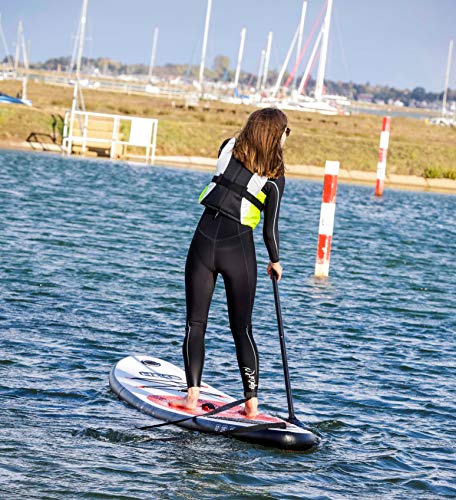
Paddleboarding is not just a fun and relaxing water sport; it can also be an excellent way to enhance your athletic performance. By incorporating specific paddleboard exercises into your training routine, you can improve your balance, core strength, and overall fitness, in fact many people even take up paddleboard racing. In this article, we’ll explore a variety of paddleboard exercises that can help you take your athletic performance to the next level. So, let’s get started!
Balance and Stability
One of the key benefits of paddleboarding is its ability to improve balance and stability, essential skills for virtually any sport. Here are a few exercises to help you develop your balance on the paddleboard:
- One-legged squats: Stand on your paddleboard with your feet hip-width apart. Lift one foot off the board and extend it out in front of you. Slowly bend your standing leg, lowering your body into a squat position. Hold for a moment, then push back up to the starting position. Repeat on the other leg.
- Side plank: Lie on your side on the paddleboard, with your elbow directly under your shoulder and your legs extended. Lift your hips off the board, creating a straight line from your head to your feet. Hold this position for 30 seconds, then switch to the other side.
Core Strength
A strong core is crucial for maintaining stability and generating power in many sports. Try these paddleboard exercises to strengthen your core muscles:
- Russian twists: Sit on your paddleboard with your knees bent and your feet flat on the board. Lean back slightly and lift your feet off the board, balancing on your sit bones. Hold a paddle with both hands and twist your torso to one side, touching the paddle to the board. Repeat on the other side.
- Paddleboard plank: Get into a plank position on your paddleboard, with your forearms on the board and your legs extended. Engage your core muscles and hold this position for as long as you can, aiming for at least 30 seconds.
Upper Body Strength
Paddleboarding requires a strong upper body to propel yourself through the water. Incorporate these exercises into your routine to boost your upper body strength:
- Push-ups: Get into a plank position on your paddleboard, with your hands slightly wider than shoulder-width apart. Lower your body towards the board, bending your elbows to a 90-degree angle. Push back up to the starting position, engaging your chest and arm muscles.
- Paddle sprints: Start in a regular paddling stance on your paddleboard. Perform quick, powerful paddle strokes for 30 seconds, focusing on engaging your upper body muscles. Rest for 30 seconds, then repeat.
Lower Body Strength
Although it may not seem obvious, paddleboarding can also help strengthen your lower body. Try these exercises to target your leg muscles:
- Lunges: Stand on your paddleboard with your feet hip-width apart. Step forward with one foot, lowering your back knee towards the board. Push back up to the starting position and repeat on the other leg.
- Paddleboard squats: Stand on your paddleboard with your feet shoulder-width apart. Hold your paddle horizontally in front of you for balance. Slowly bend your knees, lowering your hips towards the board. Push back up to the starting position, engaging your leg muscles.
By incorporating these paddleboard exercises into your training routine, you can improve your balance, core strength, and overall fitness, ultimately enhancing your athletic performance. Be sure to check out Rock and Mountain’s extensive range of paddleboards to find the perfect board for your needs and don’t forget to visit the Rock and Mountain blog for more tips, advice, and insights on paddleboarding and other water sports.
Flexibility and Mobility
Paddleboarding can also help improve your flexibility and mobility, which are essential for injury prevention and improved athletic performance. Incorporate these stretching exercises into your paddleboarding routine:
- Forward bend: Stand on your paddleboard with your feet hip-width apart. Slowly bend forward from your hips, reaching towards your toes with your hands. Hold the stretch for a few seconds, then return to the starting position.
- Hip flexor stretch: Kneel on your paddleboard with one foot forward and the other knee on the board. Gently push your hips forward, feeling the stretch in your hip flexors. Hold for a few seconds, then switch legs.
Cardiovascular Endurance
Paddleboarding can be an effective cardiovascular workout, helping you build endurance and stamina. Try these cardio-focused paddleboarding exercises:
- Interval training: Paddle at a moderate pace for 3 minutes, then increase your speed for 30 seconds, paddling as fast as you can. Slow down and recover for 90 seconds, then repeat the cycle several times.
- Long-distance paddling: Plan a longer paddleboarding route, aiming for a continuous paddle for 45 minutes to an hour. Focus on maintaining a steady pace and efficient paddle strokes to build your endurance.
Recovery and Relaxation
Don’t forget the importance of recovery and relaxation for optimal athletic performance. Paddleboarding can be a calming and restorative activity, helping you unwind and recharge:
- SUP yoga: Incorporate yoga poses and stretches into your paddleboarding routine, focusing on deep breathing and relaxation. Try poses such as downward-facing dog, warrior, and tree pose on your paddleboard.
- Meditative paddling: Find a quiet spot on the water, and paddle slowly and mindfully, focusing on your breath and the rhythmic movement of your paddle strokes.
Incorporating paddleboarding into your fitness routine can have a significant impact on your athletic performance. Don’t forget there are different types of paddleboards with some key differences between inflatable Paddleboards and solid boards. From improving balance and core strength to enhancing flexibility and endurance, paddleboarding offers a diverse range of benefits that can help you become a better athlete. Explore Rock and Mountain’s wide selection of paddleboards and embark on a new and exciting fitness journey today!

